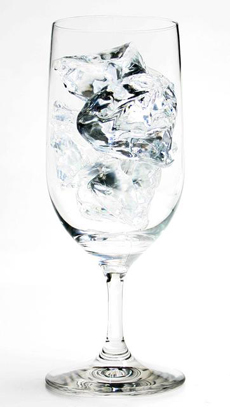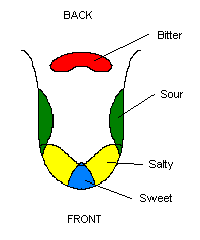
 What is the flavor of water? It’s not a zen koan! Photograph by Richard L. Bliss, courtesy of MorgueFile.com.
|
MICHAEL MASCHA is Water Editor of THE NIBBLE™ and founder of FineWaters.com, the authoritative voice for water connoisseurs. Click here to e-mail Michael.
|
|
September 2005
|
 |
Water 101
How to Evaluate a Glass of Water
Learn To Compare Waters ~ Invite Your Friends
For A Water-Tasting Party
Wine has flavor. Tea has flavor. Juice has flavor. Does water have flavor? Certainly all of the people who choose fine bottled water would say so. But unlike wine and tea descriptors such as “fruity,” “nutty” or “spicy,” how does one describe the flavor of water?
We would like to use the term flavor to describe the complex integration of smell, taste and the tactile sensation that food scientists call mouthfeel. This integration happens in the brain as a result of information relayed by sensors. This integration is a very complex process and we are just beginning to understand how it works. The simple concept is:
- Flavor = Smell + Taste + Mouthfeel
Smell (Aroma)
Humans can perceive thousands of aroma. Aromas are usually named according to the object they are associated with (“smells like … ”). Olfactory receptors are true nerve cells that live approximately 30 days. The perception of odors can occur via the nose and the oral cavity while chewing. Some studies claim that 80-90% of taste is smell—which is why one’s ability to taste can be diminished during a bad cold.
The Smell of Water: While not all water will give off a perceptible aroma, some can have a scents depending on their provenance. Here are some examples:
Taste
 The oft-cited but misleading “tongue map” at the right, showing large regional differences in sensitivity across the human tongue is not accurate. What many of us were taught was based on a mistranslation of an early-1900s German thesis that was disproved in 1974. Taste cells lie within taste buds, which are located in various tongue papillae, the hard and soft palate, and the root of the tongue. Taste buds are skin-like cells that are fairly evenly distributed on the tongue, with a life span of approximately seven days. The oft-cited but misleading “tongue map” at the right, showing large regional differences in sensitivity across the human tongue is not accurate. What many of us were taught was based on a mistranslation of an early-1900s German thesis that was disproved in 1974. Taste cells lie within taste buds, which are located in various tongue papillae, the hard and soft palate, and the root of the tongue. Taste buds are skin-like cells that are fairly evenly distributed on the tongue, with a life span of approximately seven days.
The Taste of Water: While the taste bud distribution may not lie according to the map of the tongue at the right, the buds still do perceive these taste sensations, which can be added to the chart above:
- Alkaline
- Bitter
- Calciferous
- Cool
- Flat
- Fresh
|
- Lively
- Salty/Saline
- Sour
- Stale
- Sweet
|
The taste differences in water are very subtle, especially when compared to wine and other beverages—but discernable. The particular taste of each water reflects its origin and terroir. Geological strata allow water to absorb minerals; each area’s mix of minerals contributes to the unique characteristics of a single source water (water drawn from one location). The minerals also contribute to daily dietary needs.
Distilled water is tasteless and makes no significant contribution to your a diet’s daily mineral needs. Aquafina and Dasani are examples of distilled waters to which minerals are added.
Texture & Mouthfeel
Texture is the surface quality; mouthfeel is, literally, how food or drink feels in one’s mouth. While some use the terms interchangeably, both are sensory evaluations of tactile impressions on the palate. For texture, think of the crispiness of a potato chip, the crunchiness of a pickle, cookies and crackers; the resiliency of a gum drop or marshmallow. For mouthfeel, think of the unctuousness of olive oil, the creaminess of puddings. These are just a few examples of characteristics that make food appealing and satisfying to consumers.
The Mouthfeel of Water: Although it may be one of the most important properties, a food’s mouthfeel is probably the least understood and most neglected by food writers and the most overlooked aspect of describing the flavor of water. Carbonation—or its absence—together with the size, amount, and distribution of the bubbles, is a significant contribution to the mouthfeel of water. The FineWaters Balance describes the mouthfeel of water in five levels, based on the level of carbonation:
- Still (Evian, Fiji Water, Vittel, Volvic)
- Effervescent (Badoit, Ferrarelle, Sanfaustino, Voss)
- Light (Daggio, Galvanina, Ramlosa, Sole)
- Classic (Apollinaris, Fiuggi, Gerolsteiner, Lurisia, San Pellegrino)
- Bold (Perrier, Saratoga Springs, Tipperary, Ty Nant)
Here is a brief comparison of the tastes of wine and water based on the Flavor = Taste + Smell + Mouthfeel formula:
| |
Wine |
Water |
| Smell |
Complex |
Very Subtle |
| Taste |
Complex |
Very Subtle |
| Mouthfeel |
Complex |
Complex |
What does this mean?
- When tasting water, the most important factor in its overall sensation—what we call flavor—is the mouthfeel generated by the size, amount and distribution of the bubbles, or the absence of them.
Water 101 is just the beginning of understanding how to evaluate and appreciate fine bottled waters. In other articles we will continue to explore connoisseurship and the components of water.
Lifestyle Direct Direct, Inc. All rights reserved. Images are the copyright of their respective owners.

|

 What is the flavor of water? It’s not a zen koan! Photograph by Richard L. Bliss, courtesy of MorgueFile.com.
What is the flavor of water? It’s not a zen koan! Photograph by Richard L. Bliss, courtesy of MorgueFile.com. The oft-cited but misleading “tongue map” at the right, showing large regional differences in sensitivity across the human tongue is not accurate. What many of us were taught was based on a mistranslation of an early-1900s German thesis that was disproved in 1974. Taste cells lie within taste buds, which are located in various tongue papillae, the hard and soft palate, and the root of the tongue. Taste buds are skin-like cells that are fairly evenly distributed on the tongue, with a life span of approximately seven days.
The oft-cited but misleading “tongue map” at the right, showing large regional differences in sensitivity across the human tongue is not accurate. What many of us were taught was based on a mistranslation of an early-1900s German thesis that was disproved in 1974. Taste cells lie within taste buds, which are located in various tongue papillae, the hard and soft palate, and the root of the tongue. Taste buds are skin-like cells that are fairly evenly distributed on the tongue, with a life span of approximately seven days.